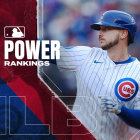Batting average can still be a useful stat. I know sometimes those of us who prefer other stats might make it seem otherwise, but it does matter. It's just that when it comes to averages, context behind it is needed, which is why we generally will always use the entire triple slash line. Then you get to see the average, the percentage of times a player doesn't make an out (the most important stat, in my humble opinion) and how well a player is hitting for power.
AVG/OBP/SLG is the slash.
One of the many problems when using only batting average is the lack of context. Picture how often you see some misguided argument that goes something like "he stinks! He's only a .245 hitter!"
That's a terrible argument in and of itself. Sure, he could stink. He could also take a ton of walks and hit for great power, making him a very valuable player. Would you like an example? Sure, I've got one.
Anthony Rizzo is a .220 hitter so far this year. Bad, right? Here's the problem: Rizzo has walked more times than he's struck out (19 to 15) and hit for great power. His .385 on base percentage dwarfs the .325 league average OBP.
But he's a cleanup-hitting first baseman, Matt! His job isn't to walk, it's to produce runs!
Cool story.
Rizzo has eight homers, which is tied for fifth in the National League. He's in second (one away from first) with 24 RBI. His .561 slugging percentage, again, dwarfs the .409 league average slugging.
On the flip-side, take a look at Alexei Ramirez. He's a ".272 hitter." That's fine. Some misguided folks would look at the two and proclaim Ramirez is having a better season. They'd be gravely mistaken, however, given that Ramirez doesn't take walks (.306 OBP, which is almost 20 points below league average) and hasn't hit for power (.315 SLG, which is almost 100 points below league average).

Now, obviously no one should be judging Rizzo and Ramirez offensively as equals given that Rizzo plays a premium offensive position (first base) and Ramirez plays a premium defensive position (shortstop), but the point here is that the old-school obsession with batting average would lead you astray.
These aren't the only ones. Here are a few more hollow averages, aside from Ramirez's. That is, qualifying hitters above the MLB mark in average but below in OBP and slugging:
Hanley Ramirez, Red Sox: .283/.305/.384
Joey Rickard, Orioles: .278/.308/.392
Ketel Marte, Mariners: .277/.315/.313
Brandon Phillips, Reds: .273/.313/.403
Kevin Pillar, Blue Jays: .271/.307/.375
Omar Infante, Royals: .270/.304/.365
Dee Gordon, Marlins (suspended now): .266/.289/.340
Billy Burns, Athletics: .265/.307/.349
Matt Duffy, Giants: .263/.308/.384
Eduardo Escobar, Twins: .256/.297/.314
And the opposite of hollow, aside from Rizzo, here are the guys below the MLB mark in average but above it in OBP and slugging:
Carlos Santana, Indians: .244/.333/.474
Matt Carpenter, Cardinals: .242/.375/.429
Jose Bautista, Blue Jays: .241/.387/.517
Kevin Kiermaier, Rays: .239/.329/.448
Curtis Granderson, Mets: .239/.343/.466
Paul Goldschmidt, Diamondbacks: .239/.424/.489
Chris Davis, Orioles: .236/.352/.494
Brandon Moss, Cardinals: .227/.325/.545
Andrew McCutchen, Pirates: .227/.342/.433
By the way, there are a lot more home runs, RBI and runs scored in this group of players on a per-man basis. Just glancing at the names, it's a far superior overall group of baseball players, too.
Give me the latter group. The throwbacks who resist change can have their precious average. We know to look deeper, because one number can always be deceiving. Next time you hear "he's a .xyz hitter," just roll your eyes knowing that you know better. Leave the hollow averages and instead focus on full triple slash lines.
![[object Object] Logo](https://sportshub.cbsistatic.com/i/2020/04/22/e9ceb731-8b3f-4c60-98fe-090ab66a2997/screen-shot-2020-04-22-at-11-04-56-am.png)

















